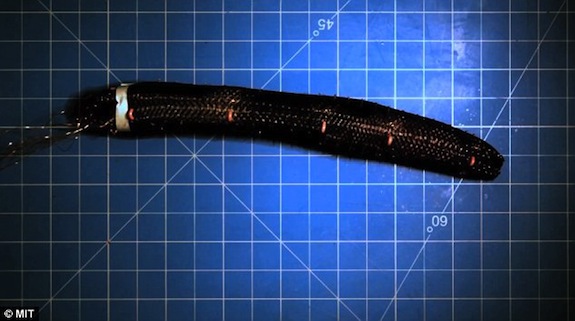Scientists Create Worm-like Robot That Can Inch Along the Ground
The Meshworm uses artificial muscles and peristalsis to creep quietly along the ground
![]()

The Meshworm uses peristalsis, contracting and expanding different muscle segments, to inch across the ground. Image via MIT
Over the past few years, engineers have increasingly looked to the natural world when inventing cutting-edge robots. Flying drones inspired by birds and insects have taken to the skies, and swimming robots based on the jellyfish have been developed for the seas.
Now, a team of scientists from MIT, Harvard and Seoul National University have been inspired by a different sort of creature for a next-generation robot: the humble earthworm. As detailed in a paper recently published in the journal Transactions on Mechatronics, a group led by professor Sangbae Kim has created a device they call “Meshworm,” a small robot that crawls along the ground in the same way worms do, using the principle of peristalsis.
The device is propelled by a spiral-shaped coil of artificial muscle made of a titanium and nickel alloy, a material chosen for a particular reason: It stretches when heated and contracts back to its original shape once cooled. The engineers used an internal battery and circuit board to apply a weak electric current to different muscle segments within the Meshworm, heating each of them in turn. When each segment is heated, it expands in length, causing the outer circumference of the mesh to briefly contract, then return to its original size quickly afterward. As this motion occurs successively at each segment, it produces a wave of contraction that enables Meshworm to crawl along the ground.
All this might sound complicated, but it looks unnervingly lifelike—you’ve likely seen it happen hundreds of times during your life in nature. In addition to earthworms, snails and sea cucumbers also move via peristalsis, and our own gastrointestinal tracts move food along using the same mechanism. See Meshworm move in the MIT video below:
Additionally, the robot features artificial muscles that run along its length on both its left and right sides. When either of these muscles are heated, they pull the device left or right, allowing it to steer in either direction as it moves forward. The autonomous robot can be programmed to move along particular pathways without human intervention.
The Meshworm has one more notable characteristic: It’s nearly indestructible. Because the device is made up almost entirely of soft parts, it can be hammered or stepped on without suffering any real damage. “You can throw it, and it won’t collapse,” Kim said in an MIT press release. “Most mechanical parts are rigid and fragile at small scale, but the parts in Meshworms are all fibrous and flexible.”
Potential uses for the concepts demonstrated in this device are varied. The research is funded by DARPA, an agency of the U.S. Department of Defense that develops new military technologies, and some speculate that the robot could someday be used in reconnaissance missions, since it could be air-dropped, launched or thrown over relatively long distances and land without harm. The researchers note that such technology could be useful for navigating rough terrain and fitting into small spaces; this, along with the fact that it operates quietly and inconspicuously, lends credence to the idea of it someday crawling along the ground as a creepy robo-spy.
But there might well be more benign uses as well. Kellar Autumn, a professor at Lewis and Clark College who studies biomechanics in robotics, told MIT that devices similar to the Meshworm could someday be useful for a wide range of applications, including both consumer technology and medical devices such endoscopes, implants and prosthetics. “Even though the robot’s body is much simpler than a real worm—it has only a few segments—it appears to have quite impressive performance,” Autumn said. “I predict that in the next decade we will see shape-changing artificial muscles in many products, such as mobile phones, portable computers and automobiles.”
/https://tf-cmsv2-smithsonianmag-media.s3.amazonaws.com/accounts/headshot/joseph-stromberg-240.jpg)
/https://tf-cmsv2-smithsonianmag-media.s3.amazonaws.com/accounts/headshot/joseph-stromberg-240.jpg)